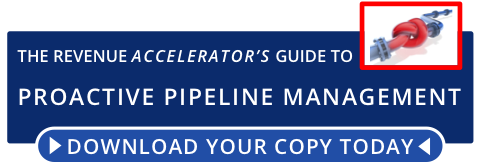Why you need to do more than name + define your sales pipeline stages
August 14, 2014

The state of the sales pipeline reflects the health of any sales process - and in anything other than the simplest of sales transactions, that process goes through multiple stages.
 Those stages have names. Sometimes they simply reflect phases in the sales process - qualified, proposed, selected, etc. There’s been a recent trend towards naming the stages after key steps in the buying decision process.
Those stages have names. Sometimes they simply reflect phases in the sales process - qualified, proposed, selected, etc. There’s been a recent trend towards naming the stages after key steps in the buying decision process.
If you’re seeking to co-ordinate the efforts of multiple sales people, it's obvious that those pipeline stages not only need to be named, they need to be defined in a clear and unambiguous way. But that's not enough...
If you’re responsible for managing a sales pipeline, you’ve probably both named and defined the key stages. But are you absolutely sure that every sales person is interpreting your definition in exactly the same consistent fashion?
Investing time in clear, detailed pipeline stage definitions pays dividends. Even better if those definitions clearly explain both what you what you expect the sales person to do - and what you anticipate the buyer will do - at each stage.
Reflecting the buyer's journey
This is where I often come across issues. It’s unfortunately often far more common for the stages to be solely or largely defined in terms of sales activities than it is to also define the parallel journey that the prospect can be expected to follow.
Expectations of the sales person are frequently poorly defined or incomplete. There's tremendous benefit to making clear what information you expect the sales person to be conveying at each stage, what questions they should be asking, and what tools are available to support them in the process.
Anticipating the issues, motivations and concerns of the key stakeholders at each stage of the process is equally invaluable, as is preparing sales people for the questions they are most likely to be asked by the prospect, and highlighting the materials that can be used to facilitate the prospect’s buying journey.
The missing link
But even then, there’s often still a missing link - and it’s one of the most important foundations of effective pipeline management. Even when stages are well defined, it’s rare for the milestones that establish the boundaries between one stage and the next to be given equivalent attention.
Without clearly defined, unambiguous milestones, it’s hard to clearly establish exactly where the prospect is in their buying decision process. And if you misinterpret that, all manner of bad things follow.
Many of today’s most common pipeline management problems and revenue forecasting misses can be attributed to the failure to insist on clear, verifiable evidence of genuine progress on the prospect’s part before the opportunity is moved to the next stage.
Never confuse sales activity with progress
Let’s be clear: “completed demo”, “submitted proposal” or any similar sales-related activities serve no useful purpose as milestones. The only milestones that matter are those associated with something the prospect can be proved to have done or said.
Without verifiable evidence that the prospect has completed the necessary action or provided the necessary information, the opportunity should stay where it is (or be moved backwards). It’s a simple as that. No milestone, no forward motion, no matter what the sales person says.
If you allow anything else, if you allow opportunities to be promoted simply because of something a sales person has done - or claims to have done - you substitute informed judgement for wishful thinking. And that way madness (and missed revenue targets) lies.
Managing by the milestones
That’s what I mean when I say that you need to do more than name and define your sales pipeline stages. You need to manage by the milestones, and insist that everyone else does the same.
Will the results be worth it? All the research suggests that organisations that master this discipline out-perform their peers by a factor of at least 20-30%, and have far fewer deals that end in an unexpected decision to “do nothing”.
Clearly defined stages and milestones are just two of the many practical recommendations we make in our recently-published Revenue Accelerator’s Guide to Proactive Pipeline Management. If you haven’t already done so, you can download your copy here.



Comments